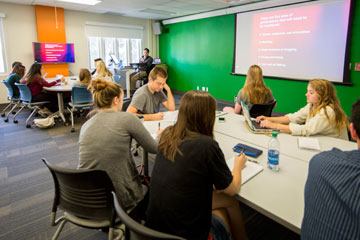What does 21st century education look like? A good place to observe is in Foley Building 210, where the CFA Innovative Learning Classroom was unveiled last semester.
A joint effort between the College of Communication and Fine Arts faculty/staff and the Academic Technology team of Information Technology Services, the new space addresses CFA’s evolving pedagogical practices, which emphasize an interactive and student-centered learning experience.
The classroom features a highly configurable, collaborative design and a host of technology solutions, including video conferencing capabilities, four 42-inch monitors, a green screen video production wall, dual projectors and ceiling microphones.
Four movable magnetic whiteboards facilitate group discussions, configurable tables and chairs can be arranged to accommodate different learning activities and pedagogical styles, and an interactive instructor monitor/whiteboard with a writable and editable surface allows for direct interaction with content.
“The new innovation lab provides a state-of-the-art teaching and learning space that challenges the imagination and encourages creativity,” said Bryant Keith Alexander, Ph.D., dean of the College of Communication and Fine Arts.
“The flexibility of the space makes it appropriate for a wide range of disciplines,” Alexander added. “In fact, most of the departments in the college — from classes in multimedia and design in studio arts and social media in communication studies, to acting for the camera in theatre and seminars in marital and family art therapy — have used the space with great success.”

The classroom, which accommodates up to 28 students, is further enhanced by dimmable lighting that can be adjusted for various activities, sound-dampening windows to minimize distractions, and environmental controls to ensure that the space is comfortable.
The process of designing the classroom involved a representative from almost every department in CFA, several CFA staff members, and several Academic Technology team members.
Faculty members brainstormed ideas for how they could best use the space, shared those ideas with their departments, and returned with priorities back to the design committee. After various plans and schemas were created and budgets were optimized, decisions were made as a design committee, including everything from the carpet colors to the monitor sizes.
The new classroom required several major renovations before the innovative design could be implemented, including new windows, air conditioning repairs, wall fixes, and paint and carpet replacement.
The success of the CFA Innovative Learning Classroom in Foley has provided even more momentum for plans to open a similar space in the Burns Fine Arts Center, home to the Department of Art and Art History, the Department of Music, and the Dance program of the Department of Theatre Arts and Dance.



